Cultural Diversity and Relevant Issues: A Sociological Analysis
VerifiedAdded on 2023/06/06
|14
|3842
|402
Essay
AI Summary
This essay delves into the multifaceted aspects of cultural diversity, focusing on the Australian context. It begins by defining culture and introducing the concept of cultural humility, contrasting it with cultural responsiveness, and examining its relevance in therapeutic settings and organizational environments. The essay then explores racism, racialization, and social Darwinism, analyzing their impact on multicultural practices and promoting anti-racist approaches. It examines Australia's cultural diversity and immigration policies, highlighting the historical White Australia Policy and the prevalence of racial prejudice despite multiculturalism. The essay further discusses learning theory and its application to managing cultural diversity in healthcare and education. Finally, it addresses post-war immigration in Australia, the abolishment of the White Australia policy, and the need for sustainable population policies. Throughout the essay, sociological theories like psychodynamic theory, symbolic interaction theory, and conflict theory are applied to provide a comprehensive understanding of the issues discussed.
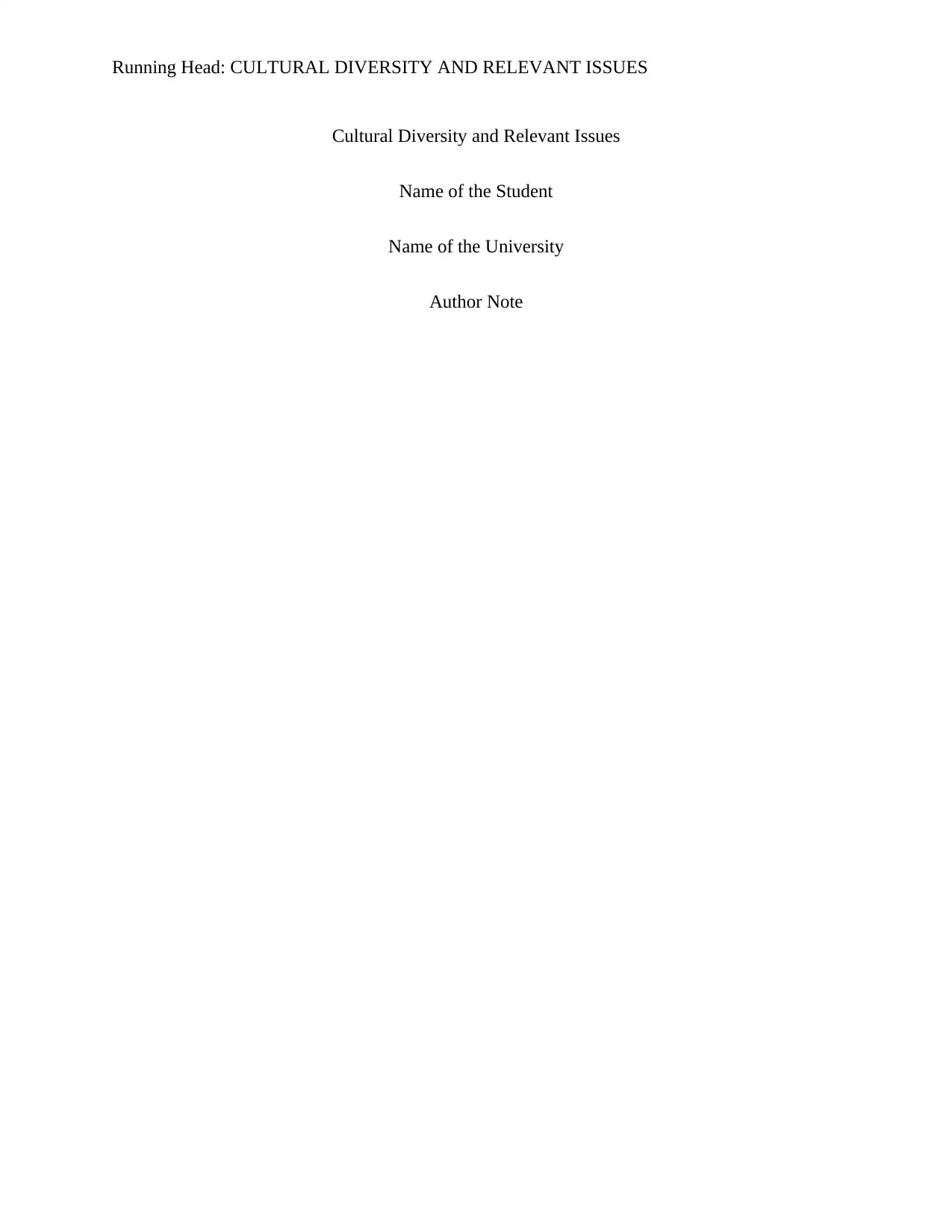
Running Head: CULTURAL DIVERSITY AND RELEVANT ISSUES
Cultural Diversity and Relevant Issues
Name of the Student
Name of the University
Author Note
Cultural Diversity and Relevant Issues
Name of the Student
Name of the University
Author Note
Paraphrase This Document
Need a fresh take? Get an instant paraphrase of this document with our AI Paraphraser
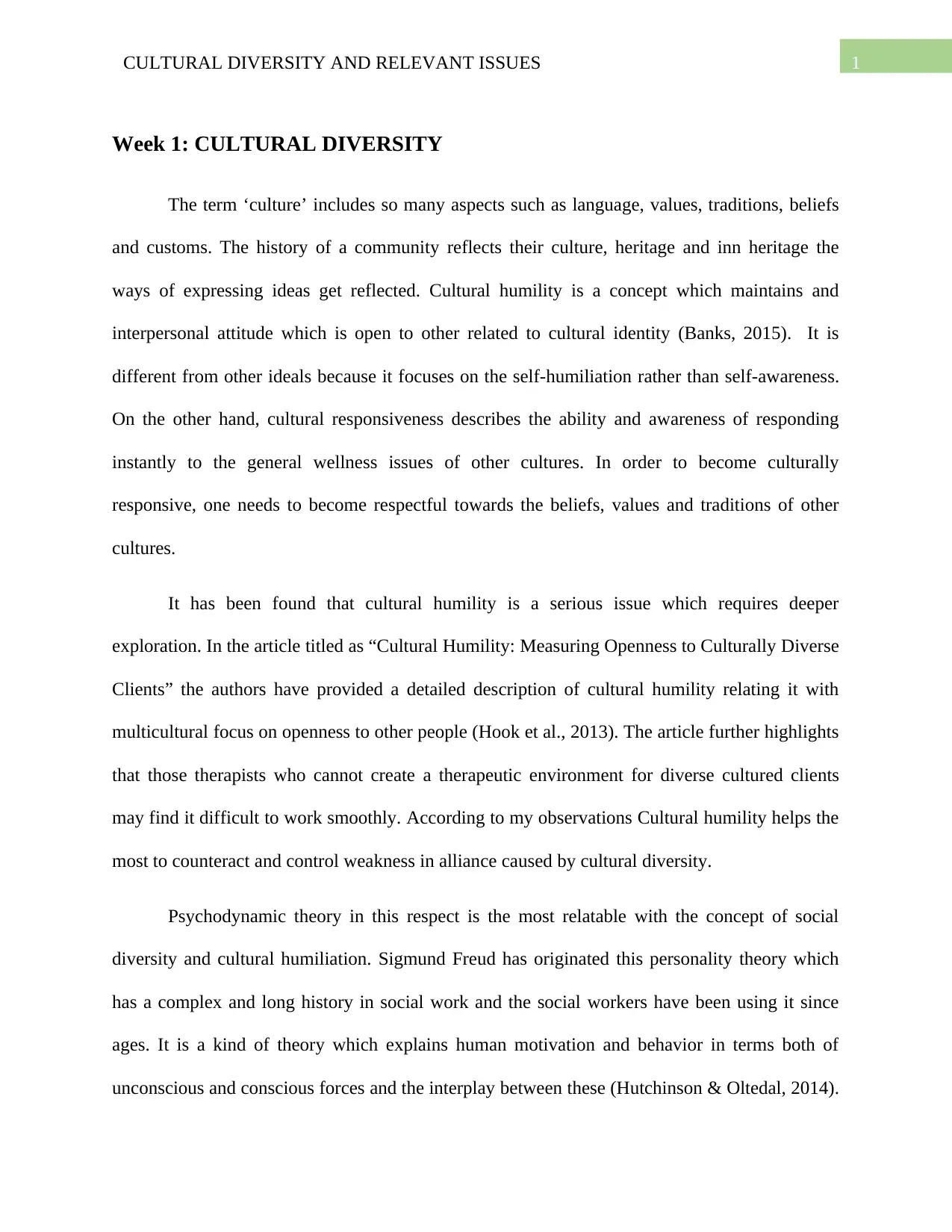
1CULTURAL DIVERSITY AND RELEVANT ISSUES
Week 1: CULTURAL DIVERSITY
The term ‘culture’ includes so many aspects such as language, values, traditions, beliefs
and customs. The history of a community reflects their culture, heritage and inn heritage the
ways of expressing ideas get reflected. Cultural humility is a concept which maintains and
interpersonal attitude which is open to other related to cultural identity (Banks, 2015). It is
different from other ideals because it focuses on the self-humiliation rather than self-awareness.
On the other hand, cultural responsiveness describes the ability and awareness of responding
instantly to the general wellness issues of other cultures. In order to become culturally
responsive, one needs to become respectful towards the beliefs, values and traditions of other
cultures.
It has been found that cultural humility is a serious issue which requires deeper
exploration. In the article titled as “Cultural Humility: Measuring Openness to Culturally Diverse
Clients” the authors have provided a detailed description of cultural humility relating it with
multicultural focus on openness to other people (Hook et al., 2013). The article further highlights
that those therapists who cannot create a therapeutic environment for diverse cultured clients
may find it difficult to work smoothly. According to my observations Cultural humility helps the
most to counteract and control weakness in alliance caused by cultural diversity.
Psychodynamic theory in this respect is the most relatable with the concept of social
diversity and cultural humiliation. Sigmund Freud has originated this personality theory which
has a complex and long history in social work and the social workers have been using it since
ages. It is a kind of theory which explains human motivation and behavior in terms both of
unconscious and conscious forces and the interplay between these (Hutchinson & Oltedal, 2014).
Week 1: CULTURAL DIVERSITY
The term ‘culture’ includes so many aspects such as language, values, traditions, beliefs
and customs. The history of a community reflects their culture, heritage and inn heritage the
ways of expressing ideas get reflected. Cultural humility is a concept which maintains and
interpersonal attitude which is open to other related to cultural identity (Banks, 2015). It is
different from other ideals because it focuses on the self-humiliation rather than self-awareness.
On the other hand, cultural responsiveness describes the ability and awareness of responding
instantly to the general wellness issues of other cultures. In order to become culturally
responsive, one needs to become respectful towards the beliefs, values and traditions of other
cultures.
It has been found that cultural humility is a serious issue which requires deeper
exploration. In the article titled as “Cultural Humility: Measuring Openness to Culturally Diverse
Clients” the authors have provided a detailed description of cultural humility relating it with
multicultural focus on openness to other people (Hook et al., 2013). The article further highlights
that those therapists who cannot create a therapeutic environment for diverse cultured clients
may find it difficult to work smoothly. According to my observations Cultural humility helps the
most to counteract and control weakness in alliance caused by cultural diversity.
Psychodynamic theory in this respect is the most relatable with the concept of social
diversity and cultural humiliation. Sigmund Freud has originated this personality theory which
has a complex and long history in social work and the social workers have been using it since
ages. It is a kind of theory which explains human motivation and behavior in terms both of
unconscious and conscious forces and the interplay between these (Hutchinson & Oltedal, 2014).
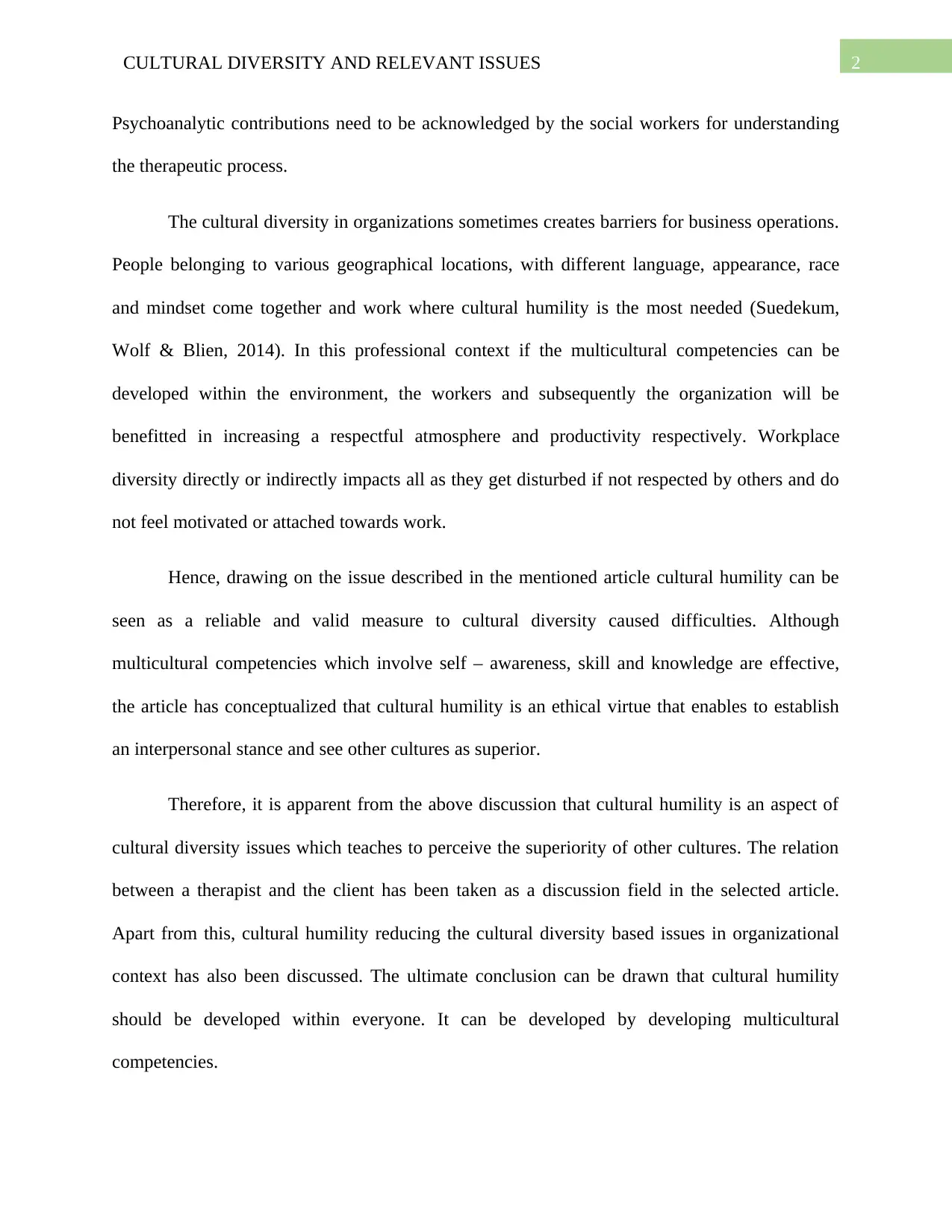
2CULTURAL DIVERSITY AND RELEVANT ISSUES
Psychoanalytic contributions need to be acknowledged by the social workers for understanding
the therapeutic process.
The cultural diversity in organizations sometimes creates barriers for business operations.
People belonging to various geographical locations, with different language, appearance, race
and mindset come together and work where cultural humility is the most needed (Suedekum,
Wolf & Blien, 2014). In this professional context if the multicultural competencies can be
developed within the environment, the workers and subsequently the organization will be
benefitted in increasing a respectful atmosphere and productivity respectively. Workplace
diversity directly or indirectly impacts all as they get disturbed if not respected by others and do
not feel motivated or attached towards work.
Hence, drawing on the issue described in the mentioned article cultural humility can be
seen as a reliable and valid measure to cultural diversity caused difficulties. Although
multicultural competencies which involve self – awareness, skill and knowledge are effective,
the article has conceptualized that cultural humility is an ethical virtue that enables to establish
an interpersonal stance and see other cultures as superior.
Therefore, it is apparent from the above discussion that cultural humility is an aspect of
cultural diversity issues which teaches to perceive the superiority of other cultures. The relation
between a therapist and the client has been taken as a discussion field in the selected article.
Apart from this, cultural humility reducing the cultural diversity based issues in organizational
context has also been discussed. The ultimate conclusion can be drawn that cultural humility
should be developed within everyone. It can be developed by developing multicultural
competencies.
Psychoanalytic contributions need to be acknowledged by the social workers for understanding
the therapeutic process.
The cultural diversity in organizations sometimes creates barriers for business operations.
People belonging to various geographical locations, with different language, appearance, race
and mindset come together and work where cultural humility is the most needed (Suedekum,
Wolf & Blien, 2014). In this professional context if the multicultural competencies can be
developed within the environment, the workers and subsequently the organization will be
benefitted in increasing a respectful atmosphere and productivity respectively. Workplace
diversity directly or indirectly impacts all as they get disturbed if not respected by others and do
not feel motivated or attached towards work.
Hence, drawing on the issue described in the mentioned article cultural humility can be
seen as a reliable and valid measure to cultural diversity caused difficulties. Although
multicultural competencies which involve self – awareness, skill and knowledge are effective,
the article has conceptualized that cultural humility is an ethical virtue that enables to establish
an interpersonal stance and see other cultures as superior.
Therefore, it is apparent from the above discussion that cultural humility is an aspect of
cultural diversity issues which teaches to perceive the superiority of other cultures. The relation
between a therapist and the client has been taken as a discussion field in the selected article.
Apart from this, cultural humility reducing the cultural diversity based issues in organizational
context has also been discussed. The ultimate conclusion can be drawn that cultural humility
should be developed within everyone. It can be developed by developing multicultural
competencies.
⊘ This is a preview!⊘
Do you want full access?
Subscribe today to unlock all pages.

Trusted by 1+ million students worldwide
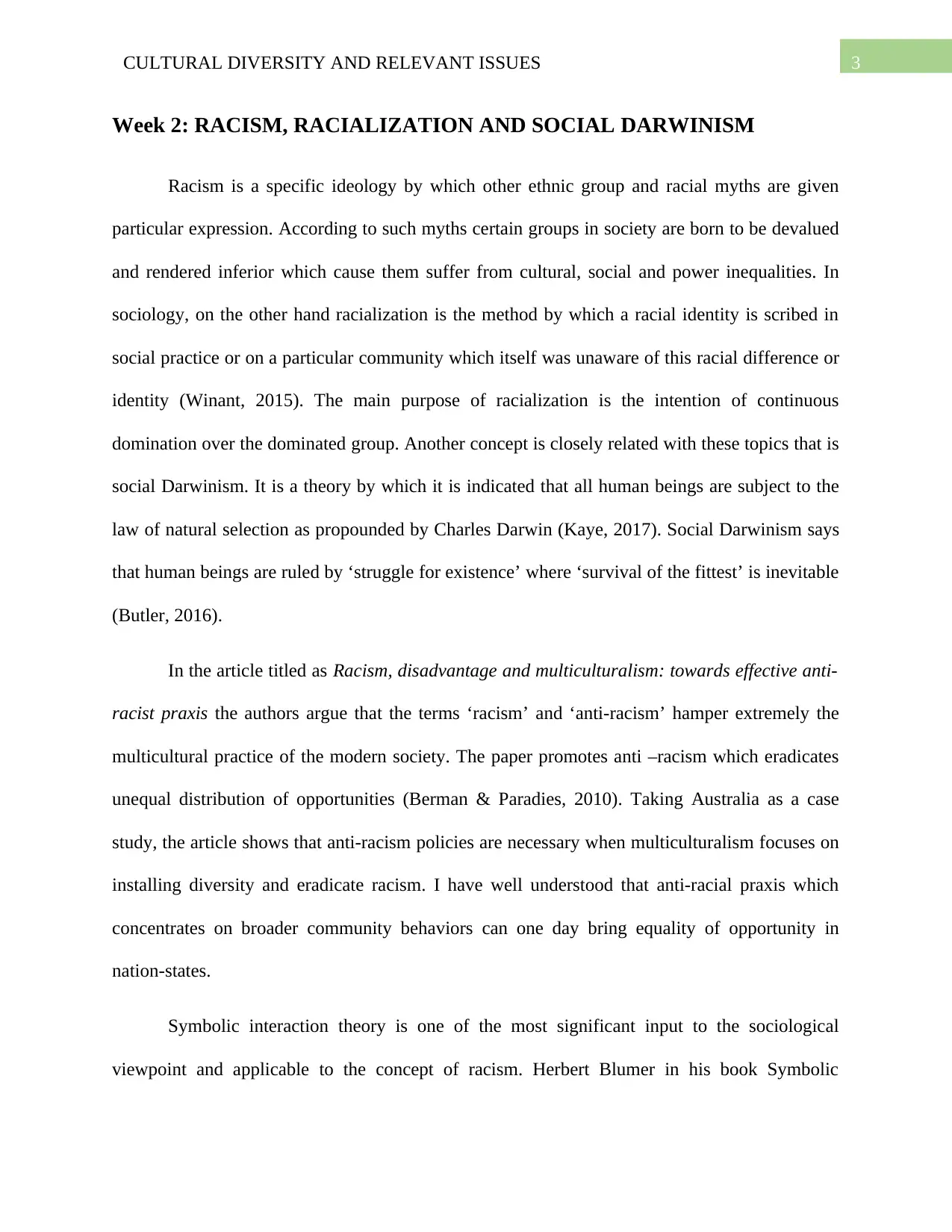
3CULTURAL DIVERSITY AND RELEVANT ISSUES
Week 2: RACISM, RACIALIZATION AND SOCIAL DARWINISM
Racism is a specific ideology by which other ethnic group and racial myths are given
particular expression. According to such myths certain groups in society are born to be devalued
and rendered inferior which cause them suffer from cultural, social and power inequalities. In
sociology, on the other hand racialization is the method by which a racial identity is scribed in
social practice or on a particular community which itself was unaware of this racial difference or
identity (Winant, 2015). The main purpose of racialization is the intention of continuous
domination over the dominated group. Another concept is closely related with these topics that is
social Darwinism. It is a theory by which it is indicated that all human beings are subject to the
law of natural selection as propounded by Charles Darwin (Kaye, 2017). Social Darwinism says
that human beings are ruled by ‘struggle for existence’ where ‘survival of the fittest’ is inevitable
(Butler, 2016).
In the article titled as Racism, disadvantage and multiculturalism: towards effective anti-
racist praxis the authors argue that the terms ‘racism’ and ‘anti-racism’ hamper extremely the
multicultural practice of the modern society. The paper promotes anti –racism which eradicates
unequal distribution of opportunities (Berman & Paradies, 2010). Taking Australia as a case
study, the article shows that anti-racism policies are necessary when multiculturalism focuses on
installing diversity and eradicate racism. I have well understood that anti-racial praxis which
concentrates on broader community behaviors can one day bring equality of opportunity in
nation-states.
Symbolic interaction theory is one of the most significant input to the sociological
viewpoint and applicable to the concept of racism. Herbert Blumer in his book Symbolic
Week 2: RACISM, RACIALIZATION AND SOCIAL DARWINISM
Racism is a specific ideology by which other ethnic group and racial myths are given
particular expression. According to such myths certain groups in society are born to be devalued
and rendered inferior which cause them suffer from cultural, social and power inequalities. In
sociology, on the other hand racialization is the method by which a racial identity is scribed in
social practice or on a particular community which itself was unaware of this racial difference or
identity (Winant, 2015). The main purpose of racialization is the intention of continuous
domination over the dominated group. Another concept is closely related with these topics that is
social Darwinism. It is a theory by which it is indicated that all human beings are subject to the
law of natural selection as propounded by Charles Darwin (Kaye, 2017). Social Darwinism says
that human beings are ruled by ‘struggle for existence’ where ‘survival of the fittest’ is inevitable
(Butler, 2016).
In the article titled as Racism, disadvantage and multiculturalism: towards effective anti-
racist praxis the authors argue that the terms ‘racism’ and ‘anti-racism’ hamper extremely the
multicultural practice of the modern society. The paper promotes anti –racism which eradicates
unequal distribution of opportunities (Berman & Paradies, 2010). Taking Australia as a case
study, the article shows that anti-racism policies are necessary when multiculturalism focuses on
installing diversity and eradicate racism. I have well understood that anti-racial praxis which
concentrates on broader community behaviors can one day bring equality of opportunity in
nation-states.
Symbolic interaction theory is one of the most significant input to the sociological
viewpoint and applicable to the concept of racism. Herbert Blumer in his book Symbolic
Paraphrase This Document
Need a fresh take? Get an instant paraphrase of this document with our AI Paraphraser
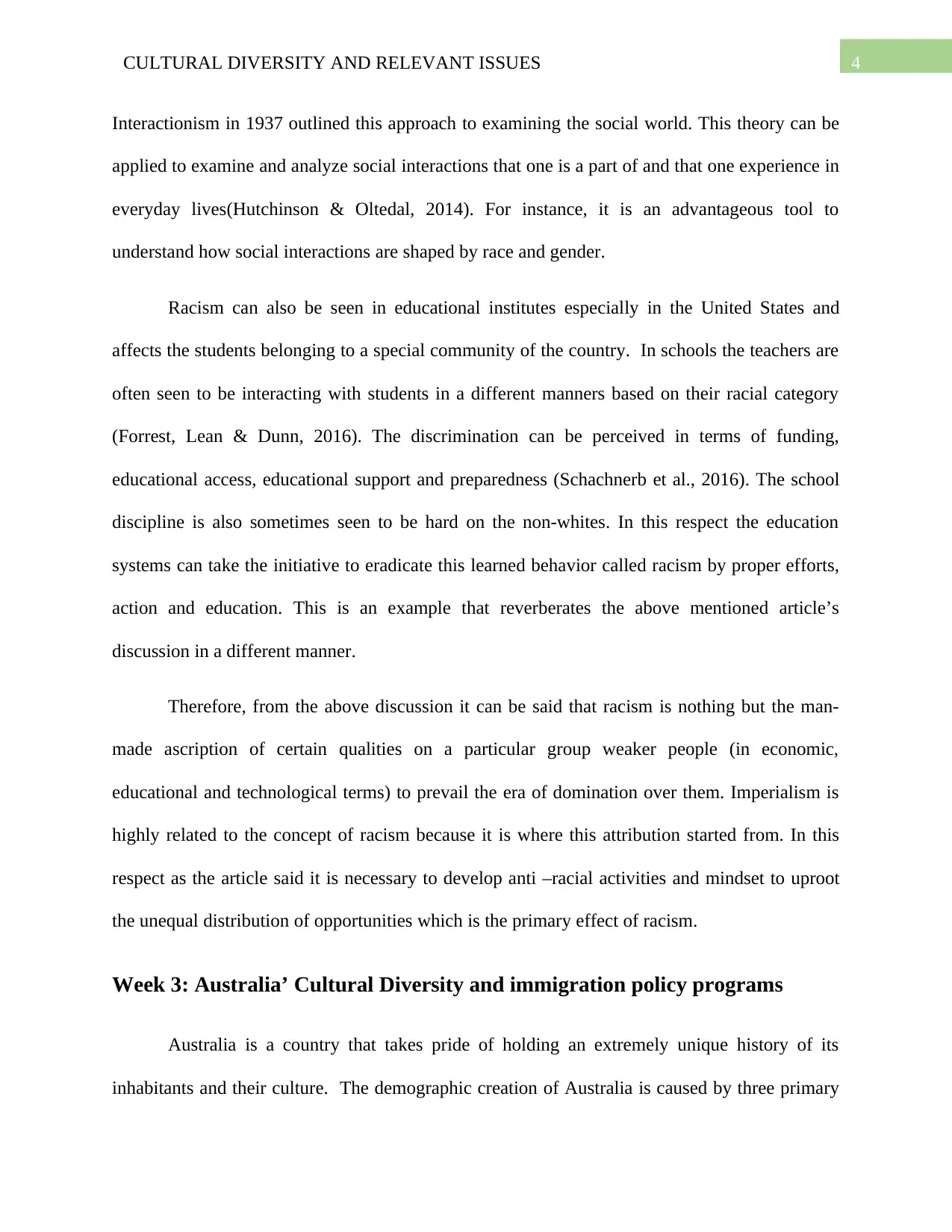
4CULTURAL DIVERSITY AND RELEVANT ISSUES
Interactionism in 1937 outlined this approach to examining the social world. This theory can be
applied to examine and analyze social interactions that one is a part of and that one experience in
everyday lives(Hutchinson & Oltedal, 2014). For instance, it is an advantageous tool to
understand how social interactions are shaped by race and gender.
Racism can also be seen in educational institutes especially in the United States and
affects the students belonging to a special community of the country. In schools the teachers are
often seen to be interacting with students in a different manners based on their racial category
(Forrest, Lean & Dunn, 2016). The discrimination can be perceived in terms of funding,
educational access, educational support and preparedness (Schachnerb et al., 2016). The school
discipline is also sometimes seen to be hard on the non-whites. In this respect the education
systems can take the initiative to eradicate this learned behavior called racism by proper efforts,
action and education. This is an example that reverberates the above mentioned article’s
discussion in a different manner.
Therefore, from the above discussion it can be said that racism is nothing but the man-
made ascription of certain qualities on a particular group weaker people (in economic,
educational and technological terms) to prevail the era of domination over them. Imperialism is
highly related to the concept of racism because it is where this attribution started from. In this
respect as the article said it is necessary to develop anti –racial activities and mindset to uproot
the unequal distribution of opportunities which is the primary effect of racism.
Week 3: Australia’ Cultural Diversity and immigration policy programs
Australia is a country that takes pride of holding an extremely unique history of its
inhabitants and their culture. The demographic creation of Australia is caused by three primary
Interactionism in 1937 outlined this approach to examining the social world. This theory can be
applied to examine and analyze social interactions that one is a part of and that one experience in
everyday lives(Hutchinson & Oltedal, 2014). For instance, it is an advantageous tool to
understand how social interactions are shaped by race and gender.
Racism can also be seen in educational institutes especially in the United States and
affects the students belonging to a special community of the country. In schools the teachers are
often seen to be interacting with students in a different manners based on their racial category
(Forrest, Lean & Dunn, 2016). The discrimination can be perceived in terms of funding,
educational access, educational support and preparedness (Schachnerb et al., 2016). The school
discipline is also sometimes seen to be hard on the non-whites. In this respect the education
systems can take the initiative to eradicate this learned behavior called racism by proper efforts,
action and education. This is an example that reverberates the above mentioned article’s
discussion in a different manner.
Therefore, from the above discussion it can be said that racism is nothing but the man-
made ascription of certain qualities on a particular group weaker people (in economic,
educational and technological terms) to prevail the era of domination over them. Imperialism is
highly related to the concept of racism because it is where this attribution started from. In this
respect as the article said it is necessary to develop anti –racial activities and mindset to uproot
the unequal distribution of opportunities which is the primary effect of racism.
Week 3: Australia’ Cultural Diversity and immigration policy programs
Australia is a country that takes pride of holding an extremely unique history of its
inhabitants and their culture. The demographic creation of Australia is caused by three primary
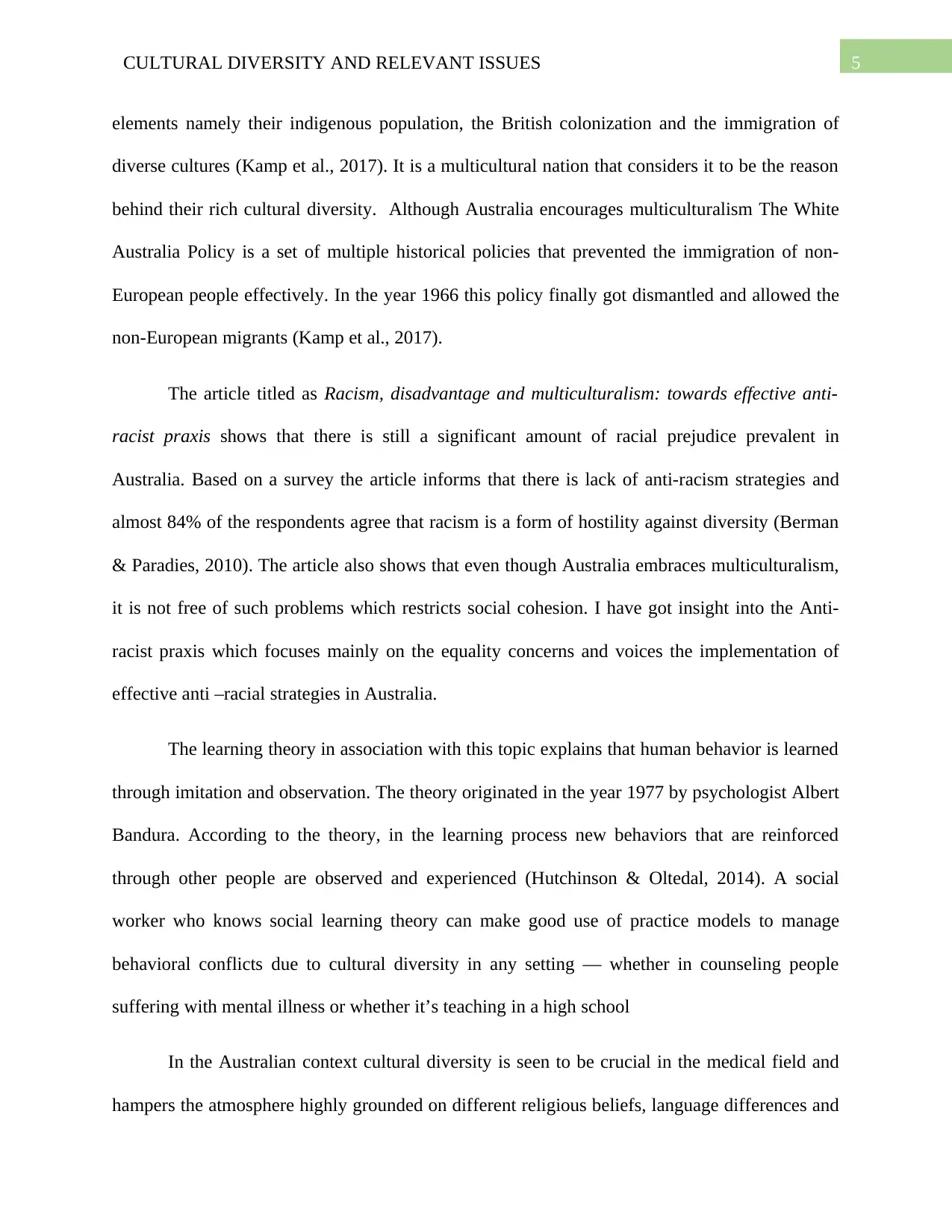
5CULTURAL DIVERSITY AND RELEVANT ISSUES
elements namely their indigenous population, the British colonization and the immigration of
diverse cultures (Kamp et al., 2017). It is a multicultural nation that considers it to be the reason
behind their rich cultural diversity. Although Australia encourages multiculturalism The White
Australia Policy is a set of multiple historical policies that prevented the immigration of non-
European people effectively. In the year 1966 this policy finally got dismantled and allowed the
non-European migrants (Kamp et al., 2017).
The article titled as Racism, disadvantage and multiculturalism: towards effective anti-
racist praxis shows that there is still a significant amount of racial prejudice prevalent in
Australia. Based on a survey the article informs that there is lack of anti-racism strategies and
almost 84% of the respondents agree that racism is a form of hostility against diversity (Berman
& Paradies, 2010). The article also shows that even though Australia embraces multiculturalism,
it is not free of such problems which restricts social cohesion. I have got insight into the Anti-
racist praxis which focuses mainly on the equality concerns and voices the implementation of
effective anti –racial strategies in Australia.
The learning theory in association with this topic explains that human behavior is learned
through imitation and observation. The theory originated in the year 1977 by psychologist Albert
Bandura. According to the theory, in the learning process new behaviors that are reinforced
through other people are observed and experienced (Hutchinson & Oltedal, 2014). A social
worker who knows social learning theory can make good use of practice models to manage
behavioral conflicts due to cultural diversity in any setting — whether in counseling people
suffering with mental illness or whether it’s teaching in a high school
In the Australian context cultural diversity is seen to be crucial in the medical field and
hampers the atmosphere highly grounded on different religious beliefs, language differences and
elements namely their indigenous population, the British colonization and the immigration of
diverse cultures (Kamp et al., 2017). It is a multicultural nation that considers it to be the reason
behind their rich cultural diversity. Although Australia encourages multiculturalism The White
Australia Policy is a set of multiple historical policies that prevented the immigration of non-
European people effectively. In the year 1966 this policy finally got dismantled and allowed the
non-European migrants (Kamp et al., 2017).
The article titled as Racism, disadvantage and multiculturalism: towards effective anti-
racist praxis shows that there is still a significant amount of racial prejudice prevalent in
Australia. Based on a survey the article informs that there is lack of anti-racism strategies and
almost 84% of the respondents agree that racism is a form of hostility against diversity (Berman
& Paradies, 2010). The article also shows that even though Australia embraces multiculturalism,
it is not free of such problems which restricts social cohesion. I have got insight into the Anti-
racist praxis which focuses mainly on the equality concerns and voices the implementation of
effective anti –racial strategies in Australia.
The learning theory in association with this topic explains that human behavior is learned
through imitation and observation. The theory originated in the year 1977 by psychologist Albert
Bandura. According to the theory, in the learning process new behaviors that are reinforced
through other people are observed and experienced (Hutchinson & Oltedal, 2014). A social
worker who knows social learning theory can make good use of practice models to manage
behavioral conflicts due to cultural diversity in any setting — whether in counseling people
suffering with mental illness or whether it’s teaching in a high school
In the Australian context cultural diversity is seen to be crucial in the medical field and
hampers the atmosphere highly grounded on different religious beliefs, language differences and
⊘ This is a preview!⊘
Do you want full access?
Subscribe today to unlock all pages.

Trusted by 1+ million students worldwide
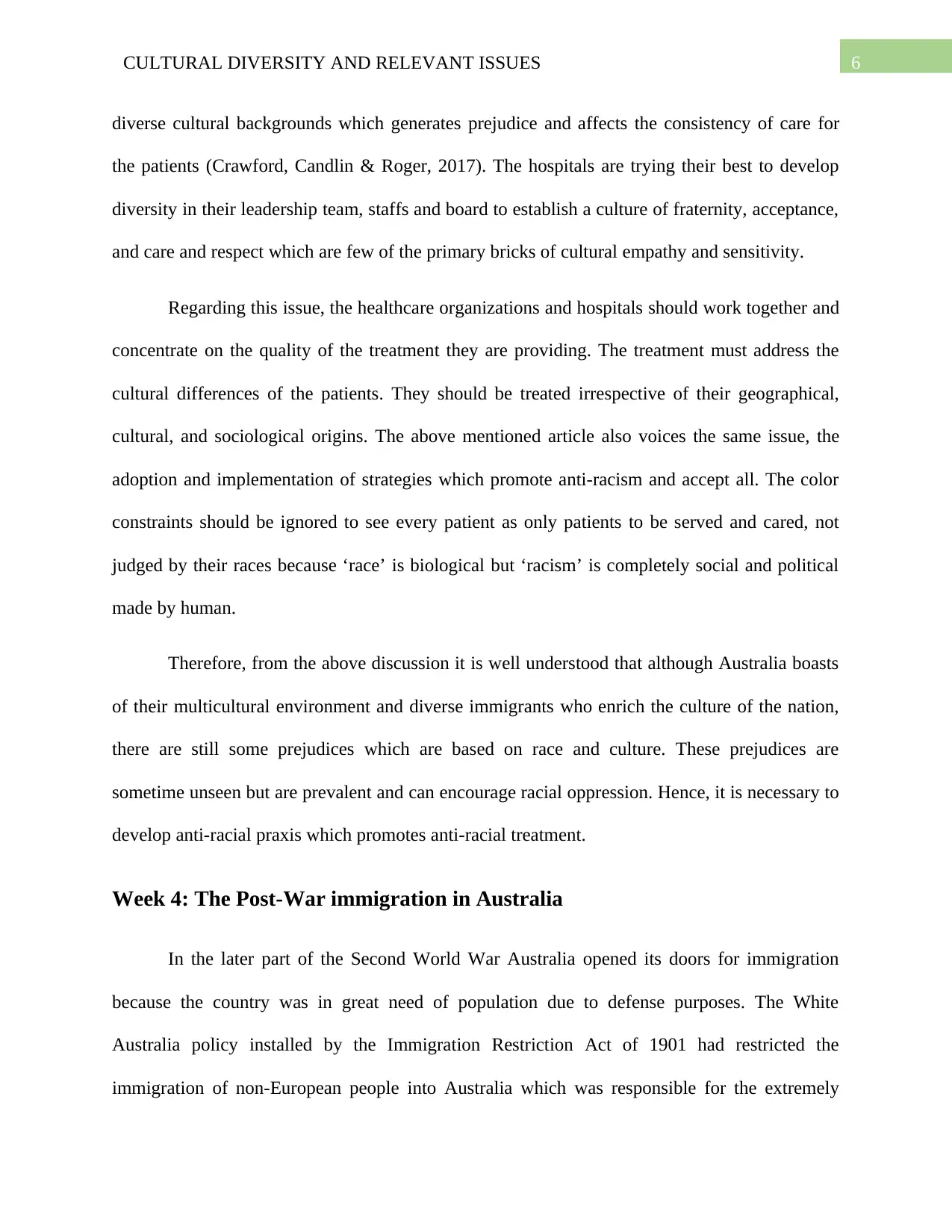
6CULTURAL DIVERSITY AND RELEVANT ISSUES
diverse cultural backgrounds which generates prejudice and affects the consistency of care for
the patients (Crawford, Candlin & Roger, 2017). The hospitals are trying their best to develop
diversity in their leadership team, staffs and board to establish a culture of fraternity, acceptance,
and care and respect which are few of the primary bricks of cultural empathy and sensitivity.
Regarding this issue, the healthcare organizations and hospitals should work together and
concentrate on the quality of the treatment they are providing. The treatment must address the
cultural differences of the patients. They should be treated irrespective of their geographical,
cultural, and sociological origins. The above mentioned article also voices the same issue, the
adoption and implementation of strategies which promote anti-racism and accept all. The color
constraints should be ignored to see every patient as only patients to be served and cared, not
judged by their races because ‘race’ is biological but ‘racism’ is completely social and political
made by human.
Therefore, from the above discussion it is well understood that although Australia boasts
of their multicultural environment and diverse immigrants who enrich the culture of the nation,
there are still some prejudices which are based on race and culture. These prejudices are
sometime unseen but are prevalent and can encourage racial oppression. Hence, it is necessary to
develop anti-racial praxis which promotes anti-racial treatment.
Week 4: The Post-War immigration in Australia
In the later part of the Second World War Australia opened its doors for immigration
because the country was in great need of population due to defense purposes. The White
Australia policy installed by the Immigration Restriction Act of 1901 had restricted the
immigration of non-European people into Australia which was responsible for the extremely
diverse cultural backgrounds which generates prejudice and affects the consistency of care for
the patients (Crawford, Candlin & Roger, 2017). The hospitals are trying their best to develop
diversity in their leadership team, staffs and board to establish a culture of fraternity, acceptance,
and care and respect which are few of the primary bricks of cultural empathy and sensitivity.
Regarding this issue, the healthcare organizations and hospitals should work together and
concentrate on the quality of the treatment they are providing. The treatment must address the
cultural differences of the patients. They should be treated irrespective of their geographical,
cultural, and sociological origins. The above mentioned article also voices the same issue, the
adoption and implementation of strategies which promote anti-racism and accept all. The color
constraints should be ignored to see every patient as only patients to be served and cared, not
judged by their races because ‘race’ is biological but ‘racism’ is completely social and political
made by human.
Therefore, from the above discussion it is well understood that although Australia boasts
of their multicultural environment and diverse immigrants who enrich the culture of the nation,
there are still some prejudices which are based on race and culture. These prejudices are
sometime unseen but are prevalent and can encourage racial oppression. Hence, it is necessary to
develop anti-racial praxis which promotes anti-racial treatment.
Week 4: The Post-War immigration in Australia
In the later part of the Second World War Australia opened its doors for immigration
because the country was in great need of population due to defense purposes. The White
Australia policy installed by the Immigration Restriction Act of 1901 had restricted the
immigration of non-European people into Australia which was responsible for the extremely
Paraphrase This Document
Need a fresh take? Get an instant paraphrase of this document with our AI Paraphraser
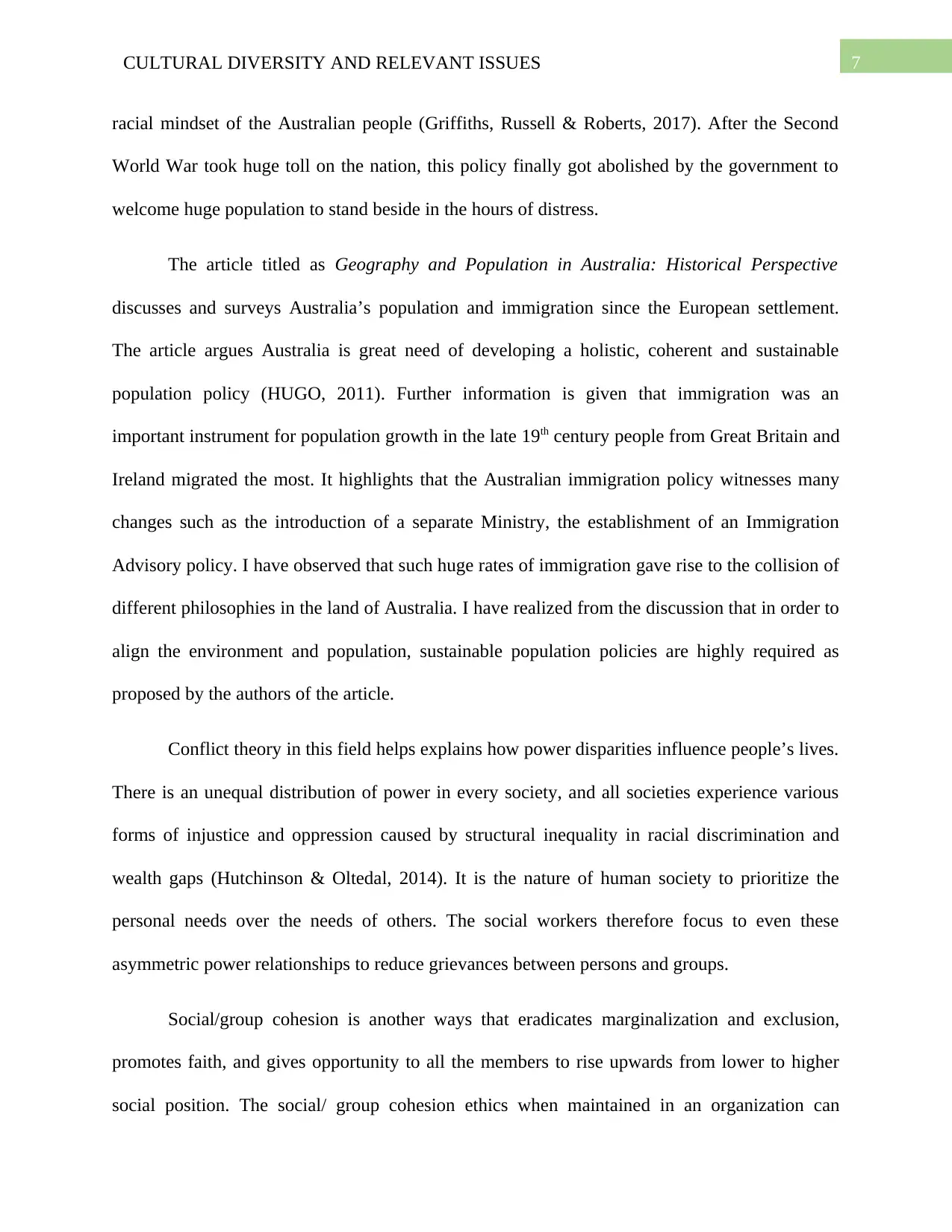
7CULTURAL DIVERSITY AND RELEVANT ISSUES
racial mindset of the Australian people (Griffiths, Russell & Roberts, 2017). After the Second
World War took huge toll on the nation, this policy finally got abolished by the government to
welcome huge population to stand beside in the hours of distress.
The article titled as Geography and Population in Australia: Historical Perspective
discusses and surveys Australia’s population and immigration since the European settlement.
The article argues Australia is great need of developing a holistic, coherent and sustainable
population policy (HUGO, 2011). Further information is given that immigration was an
important instrument for population growth in the late 19th century people from Great Britain and
Ireland migrated the most. It highlights that the Australian immigration policy witnesses many
changes such as the introduction of a separate Ministry, the establishment of an Immigration
Advisory policy. I have observed that such huge rates of immigration gave rise to the collision of
different philosophies in the land of Australia. I have realized from the discussion that in order to
align the environment and population, sustainable population policies are highly required as
proposed by the authors of the article.
Conflict theory in this field helps explains how power disparities influence people’s lives.
There is an unequal distribution of power in every society, and all societies experience various
forms of injustice and oppression caused by structural inequality in racial discrimination and
wealth gaps (Hutchinson & Oltedal, 2014). It is the nature of human society to prioritize the
personal needs over the needs of others. The social workers therefore focus to even these
asymmetric power relationships to reduce grievances between persons and groups.
Social/group cohesion is another ways that eradicates marginalization and exclusion,
promotes faith, and gives opportunity to all the members to rise upwards from lower to higher
social position. The social/ group cohesion ethics when maintained in an organization can
racial mindset of the Australian people (Griffiths, Russell & Roberts, 2017). After the Second
World War took huge toll on the nation, this policy finally got abolished by the government to
welcome huge population to stand beside in the hours of distress.
The article titled as Geography and Population in Australia: Historical Perspective
discusses and surveys Australia’s population and immigration since the European settlement.
The article argues Australia is great need of developing a holistic, coherent and sustainable
population policy (HUGO, 2011). Further information is given that immigration was an
important instrument for population growth in the late 19th century people from Great Britain and
Ireland migrated the most. It highlights that the Australian immigration policy witnesses many
changes such as the introduction of a separate Ministry, the establishment of an Immigration
Advisory policy. I have observed that such huge rates of immigration gave rise to the collision of
different philosophies in the land of Australia. I have realized from the discussion that in order to
align the environment and population, sustainable population policies are highly required as
proposed by the authors of the article.
Conflict theory in this field helps explains how power disparities influence people’s lives.
There is an unequal distribution of power in every society, and all societies experience various
forms of injustice and oppression caused by structural inequality in racial discrimination and
wealth gaps (Hutchinson & Oltedal, 2014). It is the nature of human society to prioritize the
personal needs over the needs of others. The social workers therefore focus to even these
asymmetric power relationships to reduce grievances between persons and groups.
Social/group cohesion is another ways that eradicates marginalization and exclusion,
promotes faith, and gives opportunity to all the members to rise upwards from lower to higher
social position. The social/ group cohesion ethics when maintained in an organization can
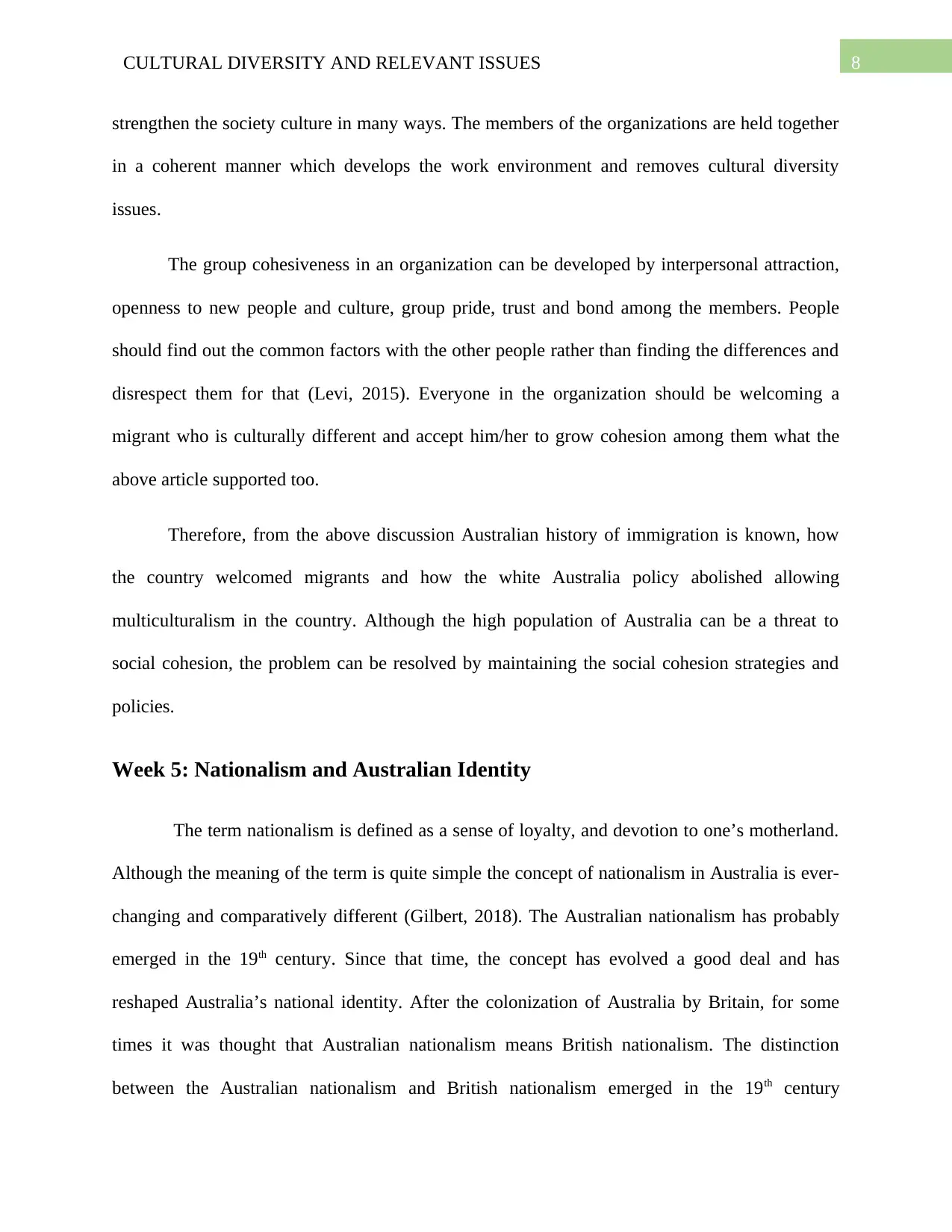
8CULTURAL DIVERSITY AND RELEVANT ISSUES
strengthen the society culture in many ways. The members of the organizations are held together
in a coherent manner which develops the work environment and removes cultural diversity
issues.
The group cohesiveness in an organization can be developed by interpersonal attraction,
openness to new people and culture, group pride, trust and bond among the members. People
should find out the common factors with the other people rather than finding the differences and
disrespect them for that (Levi, 2015). Everyone in the organization should be welcoming a
migrant who is culturally different and accept him/her to grow cohesion among them what the
above article supported too.
Therefore, from the above discussion Australian history of immigration is known, how
the country welcomed migrants and how the white Australia policy abolished allowing
multiculturalism in the country. Although the high population of Australia can be a threat to
social cohesion, the problem can be resolved by maintaining the social cohesion strategies and
policies.
Week 5: Nationalism and Australian Identity
The term nationalism is defined as a sense of loyalty, and devotion to one’s motherland.
Although the meaning of the term is quite simple the concept of nationalism in Australia is ever-
changing and comparatively different (Gilbert, 2018). The Australian nationalism has probably
emerged in the 19th century. Since that time, the concept has evolved a good deal and has
reshaped Australia’s national identity. After the colonization of Australia by Britain, for some
times it was thought that Australian nationalism means British nationalism. The distinction
between the Australian nationalism and British nationalism emerged in the 19th century
strengthen the society culture in many ways. The members of the organizations are held together
in a coherent manner which develops the work environment and removes cultural diversity
issues.
The group cohesiveness in an organization can be developed by interpersonal attraction,
openness to new people and culture, group pride, trust and bond among the members. People
should find out the common factors with the other people rather than finding the differences and
disrespect them for that (Levi, 2015). Everyone in the organization should be welcoming a
migrant who is culturally different and accept him/her to grow cohesion among them what the
above article supported too.
Therefore, from the above discussion Australian history of immigration is known, how
the country welcomed migrants and how the white Australia policy abolished allowing
multiculturalism in the country. Although the high population of Australia can be a threat to
social cohesion, the problem can be resolved by maintaining the social cohesion strategies and
policies.
Week 5: Nationalism and Australian Identity
The term nationalism is defined as a sense of loyalty, and devotion to one’s motherland.
Although the meaning of the term is quite simple the concept of nationalism in Australia is ever-
changing and comparatively different (Gilbert, 2018). The Australian nationalism has probably
emerged in the 19th century. Since that time, the concept has evolved a good deal and has
reshaped Australia’s national identity. After the colonization of Australia by Britain, for some
times it was thought that Australian nationalism means British nationalism. The distinction
between the Australian nationalism and British nationalism emerged in the 19th century
⊘ This is a preview!⊘
Do you want full access?
Subscribe today to unlock all pages.

Trusted by 1+ million students worldwide
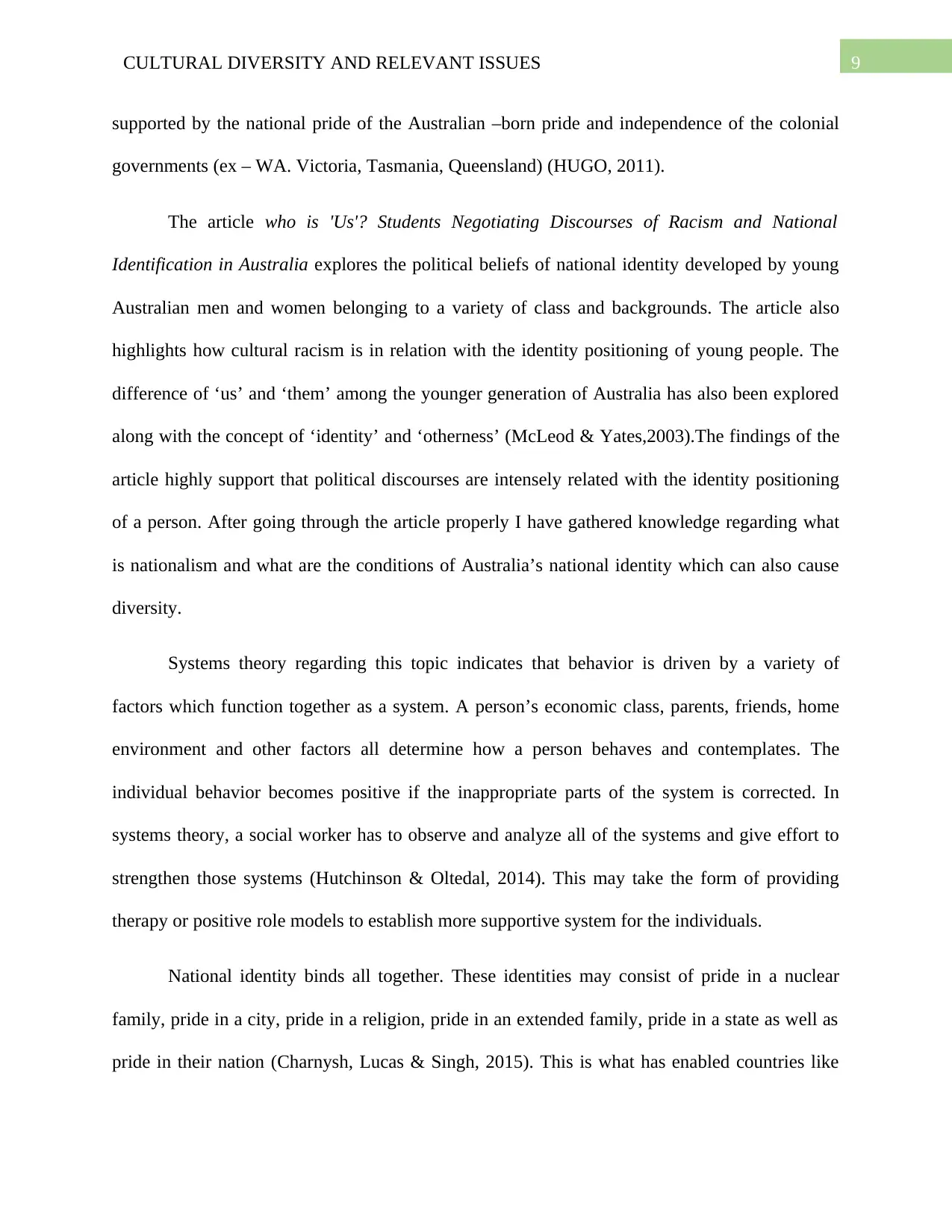
9CULTURAL DIVERSITY AND RELEVANT ISSUES
supported by the national pride of the Australian –born pride and independence of the colonial
governments (ex – WA. Victoria, Tasmania, Queensland) (HUGO, 2011).
The article who is 'Us'? Students Negotiating Discourses of Racism and National
Identification in Australia explores the political beliefs of national identity developed by young
Australian men and women belonging to a variety of class and backgrounds. The article also
highlights how cultural racism is in relation with the identity positioning of young people. The
difference of ‘us’ and ‘them’ among the younger generation of Australia has also been explored
along with the concept of ‘identity’ and ‘otherness’ (McLeod & Yates,2003).The findings of the
article highly support that political discourses are intensely related with the identity positioning
of a person. After going through the article properly I have gathered knowledge regarding what
is nationalism and what are the conditions of Australia’s national identity which can also cause
diversity.
Systems theory regarding this topic indicates that behavior is driven by a variety of
factors which function together as a system. A person’s economic class, parents, friends, home
environment and other factors all determine how a person behaves and contemplates. The
individual behavior becomes positive if the inappropriate parts of the system is corrected. In
systems theory, a social worker has to observe and analyze all of the systems and give effort to
strengthen those systems (Hutchinson & Oltedal, 2014). This may take the form of providing
therapy or positive role models to establish more supportive system for the individuals.
National identity binds all together. These identities may consist of pride in a nuclear
family, pride in a city, pride in a religion, pride in an extended family, pride in a state as well as
pride in their nation (Charnysh, Lucas & Singh, 2015). This is what has enabled countries like
supported by the national pride of the Australian –born pride and independence of the colonial
governments (ex – WA. Victoria, Tasmania, Queensland) (HUGO, 2011).
The article who is 'Us'? Students Negotiating Discourses of Racism and National
Identification in Australia explores the political beliefs of national identity developed by young
Australian men and women belonging to a variety of class and backgrounds. The article also
highlights how cultural racism is in relation with the identity positioning of young people. The
difference of ‘us’ and ‘them’ among the younger generation of Australia has also been explored
along with the concept of ‘identity’ and ‘otherness’ (McLeod & Yates,2003).The findings of the
article highly support that political discourses are intensely related with the identity positioning
of a person. After going through the article properly I have gathered knowledge regarding what
is nationalism and what are the conditions of Australia’s national identity which can also cause
diversity.
Systems theory regarding this topic indicates that behavior is driven by a variety of
factors which function together as a system. A person’s economic class, parents, friends, home
environment and other factors all determine how a person behaves and contemplates. The
individual behavior becomes positive if the inappropriate parts of the system is corrected. In
systems theory, a social worker has to observe and analyze all of the systems and give effort to
strengthen those systems (Hutchinson & Oltedal, 2014). This may take the form of providing
therapy or positive role models to establish more supportive system for the individuals.
National identity binds all together. These identities may consist of pride in a nuclear
family, pride in a city, pride in a religion, pride in an extended family, pride in a state as well as
pride in their nation (Charnysh, Lucas & Singh, 2015). This is what has enabled countries like
Paraphrase This Document
Need a fresh take? Get an instant paraphrase of this document with our AI Paraphraser
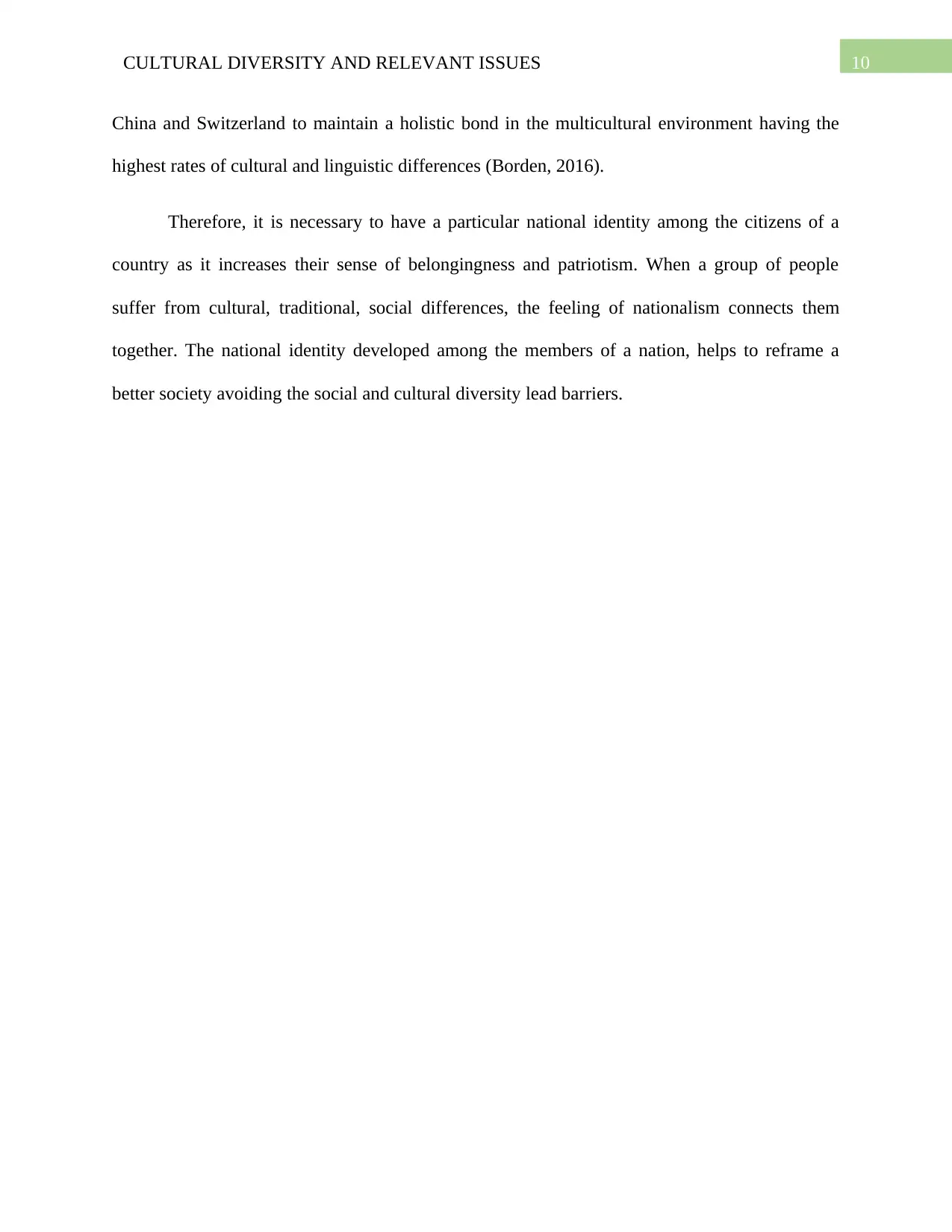
10CULTURAL DIVERSITY AND RELEVANT ISSUES
China and Switzerland to maintain a holistic bond in the multicultural environment having the
highest rates of cultural and linguistic differences (Borden, 2016).
Therefore, it is necessary to have a particular national identity among the citizens of a
country as it increases their sense of belongingness and patriotism. When a group of people
suffer from cultural, traditional, social differences, the feeling of nationalism connects them
together. The national identity developed among the members of a nation, helps to reframe a
better society avoiding the social and cultural diversity lead barriers.
China and Switzerland to maintain a holistic bond in the multicultural environment having the
highest rates of cultural and linguistic differences (Borden, 2016).
Therefore, it is necessary to have a particular national identity among the citizens of a
country as it increases their sense of belongingness and patriotism. When a group of people
suffer from cultural, traditional, social differences, the feeling of nationalism connects them
together. The national identity developed among the members of a nation, helps to reframe a
better society avoiding the social and cultural diversity lead barriers.
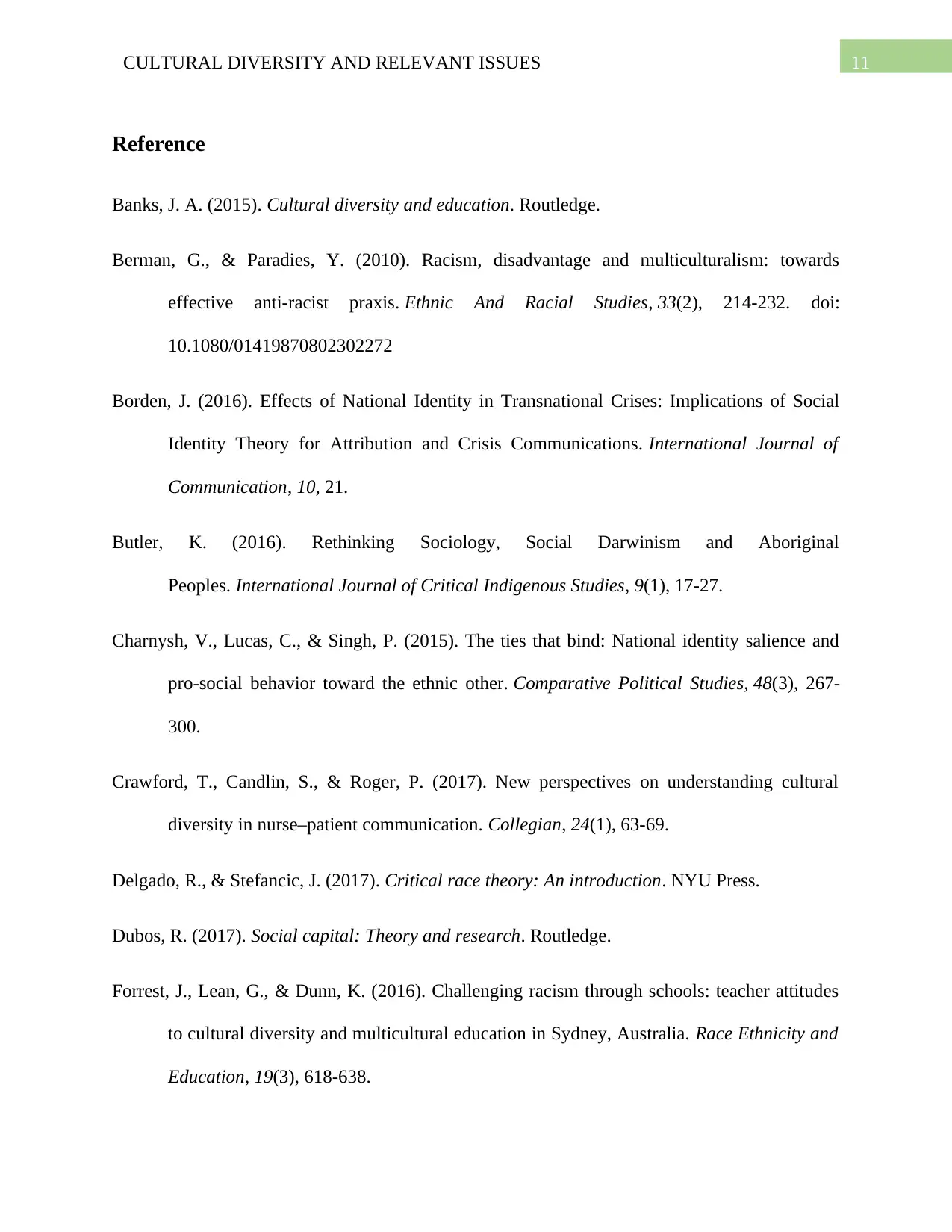
11CULTURAL DIVERSITY AND RELEVANT ISSUES
Reference
Banks, J. A. (2015). Cultural diversity and education. Routledge.
Berman, G., & Paradies, Y. (2010). Racism, disadvantage and multiculturalism: towards
effective anti-racist praxis. Ethnic And Racial Studies, 33(2), 214-232. doi:
10.1080/01419870802302272
Borden, J. (2016). Effects of National Identity in Transnational Crises: Implications of Social
Identity Theory for Attribution and Crisis Communications. International Journal of
Communication, 10, 21.
Butler, K. (2016). Rethinking Sociology, Social Darwinism and Aboriginal
Peoples. International Journal of Critical Indigenous Studies, 9(1), 17-27.
Charnysh, V., Lucas, C., & Singh, P. (2015). The ties that bind: National identity salience and
pro-social behavior toward the ethnic other. Comparative Political Studies, 48(3), 267-
300.
Crawford, T., Candlin, S., & Roger, P. (2017). New perspectives on understanding cultural
diversity in nurse–patient communication. Collegian, 24(1), 63-69.
Delgado, R., & Stefancic, J. (2017). Critical race theory: An introduction. NYU Press.
Dubos, R. (2017). Social capital: Theory and research. Routledge.
Forrest, J., Lean, G., & Dunn, K. (2016). Challenging racism through schools: teacher attitudes
to cultural diversity and multicultural education in Sydney, Australia. Race Ethnicity and
Education, 19(3), 618-638.
Reference
Banks, J. A. (2015). Cultural diversity and education. Routledge.
Berman, G., & Paradies, Y. (2010). Racism, disadvantage and multiculturalism: towards
effective anti-racist praxis. Ethnic And Racial Studies, 33(2), 214-232. doi:
10.1080/01419870802302272
Borden, J. (2016). Effects of National Identity in Transnational Crises: Implications of Social
Identity Theory for Attribution and Crisis Communications. International Journal of
Communication, 10, 21.
Butler, K. (2016). Rethinking Sociology, Social Darwinism and Aboriginal
Peoples. International Journal of Critical Indigenous Studies, 9(1), 17-27.
Charnysh, V., Lucas, C., & Singh, P. (2015). The ties that bind: National identity salience and
pro-social behavior toward the ethnic other. Comparative Political Studies, 48(3), 267-
300.
Crawford, T., Candlin, S., & Roger, P. (2017). New perspectives on understanding cultural
diversity in nurse–patient communication. Collegian, 24(1), 63-69.
Delgado, R., & Stefancic, J. (2017). Critical race theory: An introduction. NYU Press.
Dubos, R. (2017). Social capital: Theory and research. Routledge.
Forrest, J., Lean, G., & Dunn, K. (2016). Challenging racism through schools: teacher attitudes
to cultural diversity and multicultural education in Sydney, Australia. Race Ethnicity and
Education, 19(3), 618-638.
⊘ This is a preview!⊘
Do you want full access?
Subscribe today to unlock all pages.

Trusted by 1+ million students worldwide
1 out of 14
Related Documents
Your All-in-One AI-Powered Toolkit for Academic Success.
+13062052269
info@desklib.com
Available 24*7 on WhatsApp / Email
![[object Object]](/_next/static/media/star-bottom.7253800d.svg)
Unlock your academic potential
Copyright © 2020–2025 A2Z Services. All Rights Reserved. Developed and managed by ZUCOL.





